Business Law Report
VerifiedAdded on 2020/07/22
|15
|4809
|66
Report
AI Summary
This report delves into the structure of the English legal system, the role of authorities in law-making, and the implications of statutory and common law on business organizations. It discusses the impact of judicial documents, legal solutions to various situations, and the benefits of alternative dispute resolution (ADR) procedures. The report concludes with an overview of the obligations of management in relation to health and safety, harassment, and labor compensation, emphasizing the importance of adhering to business law for smooth operations.
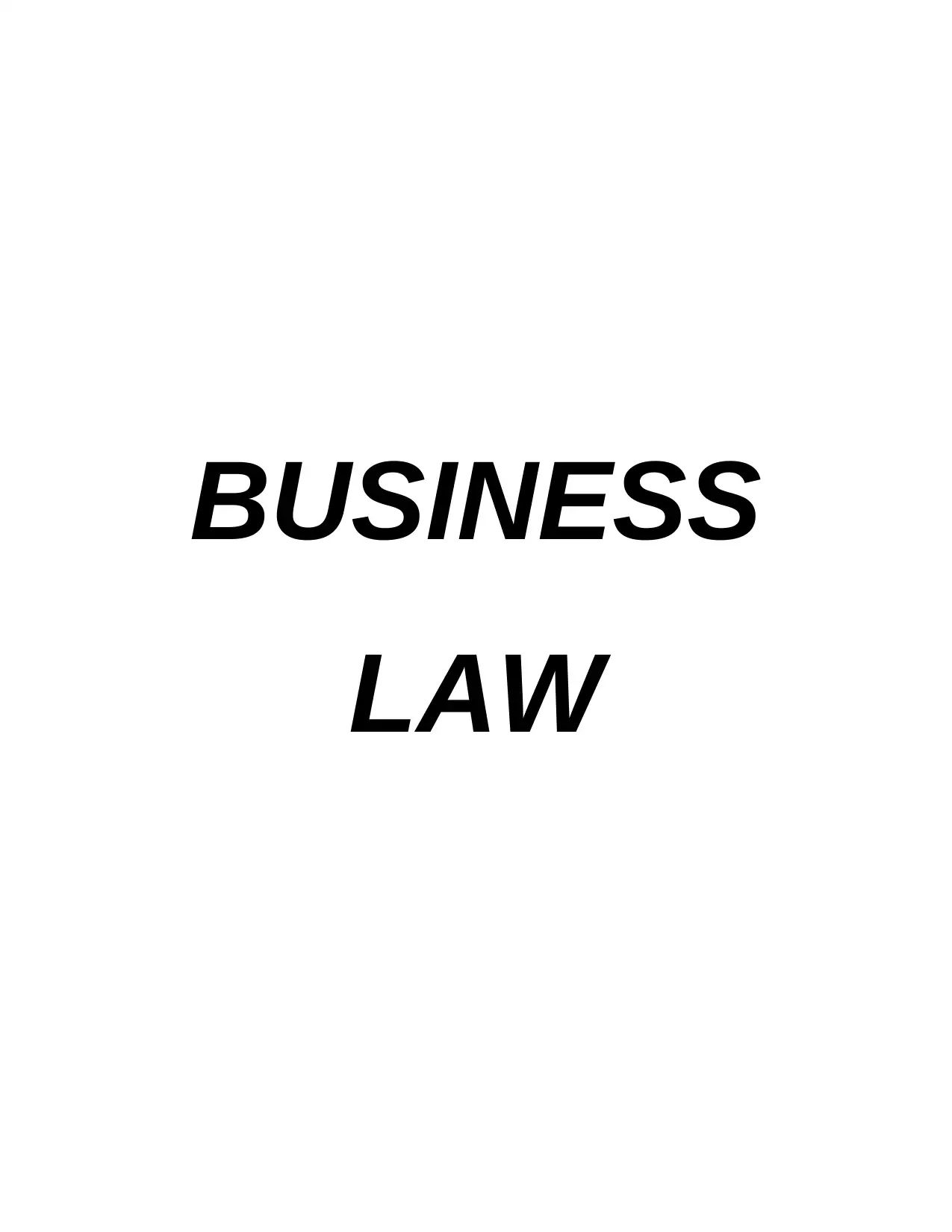
BUSINESS
LAW
LAW
Paraphrase This Document
Need a fresh take? Get an instant paraphrase of this document with our AI Paraphraser
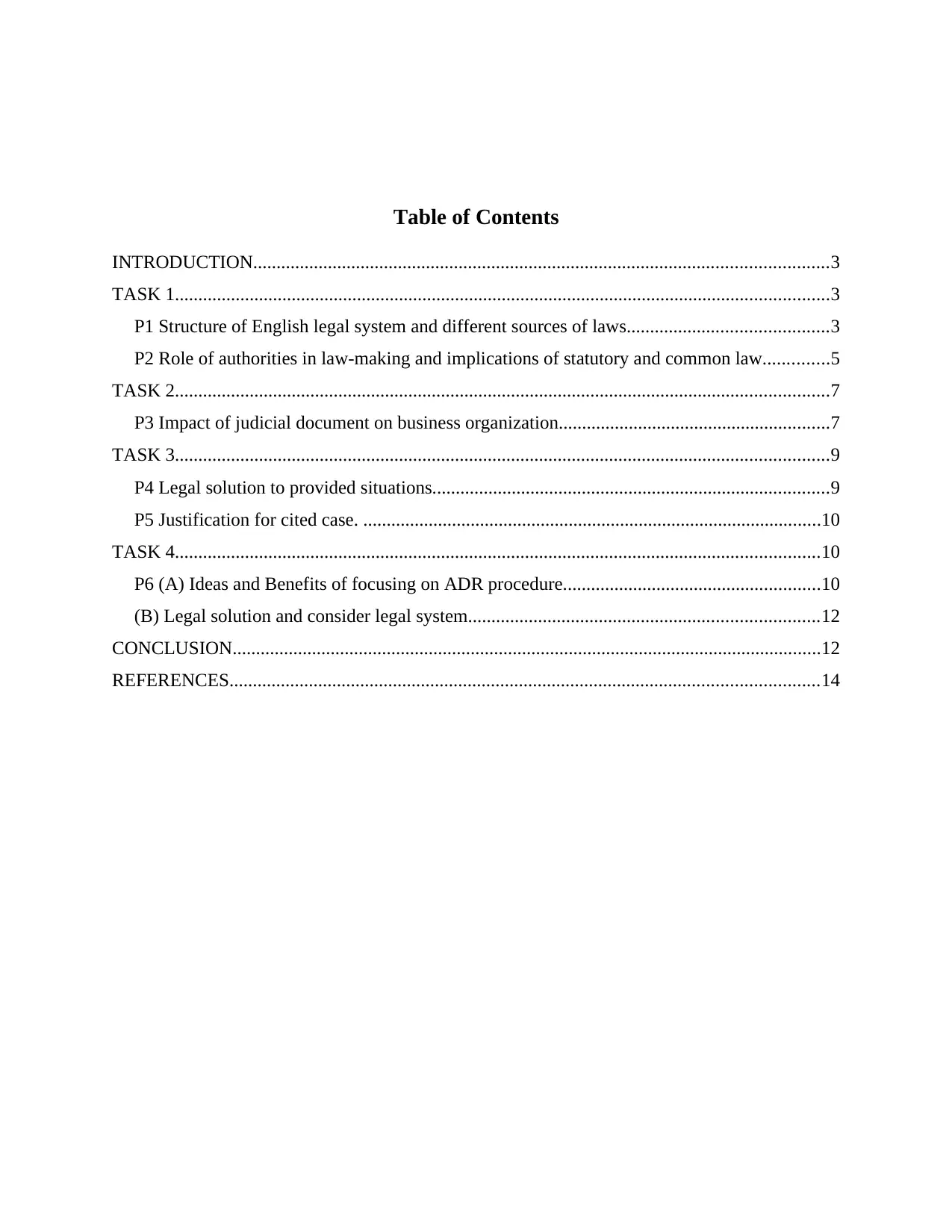
Table of Contents
INTRODUCTION...........................................................................................................................3
TASK 1............................................................................................................................................3
P1 Structure of English legal system and different sources of laws...........................................3
P2 Role of authorities in law-making and implications of statutory and common law..............5
TASK 2............................................................................................................................................7
P3 Impact of judicial document on business organization..........................................................7
TASK 3............................................................................................................................................9
P4 Legal solution to provided situations.....................................................................................9
P5 Justification for cited case. ..................................................................................................10
TASK 4..........................................................................................................................................10
P6 (A) Ideas and Benefits of focusing on ADR procedure.......................................................10
(B) Legal solution and consider legal system...........................................................................12
CONCLUSION..............................................................................................................................12
REFERENCES..............................................................................................................................14
INTRODUCTION...........................................................................................................................3
TASK 1............................................................................................................................................3
P1 Structure of English legal system and different sources of laws...........................................3
P2 Role of authorities in law-making and implications of statutory and common law..............5
TASK 2............................................................................................................................................7
P3 Impact of judicial document on business organization..........................................................7
TASK 3............................................................................................................................................9
P4 Legal solution to provided situations.....................................................................................9
P5 Justification for cited case. ..................................................................................................10
TASK 4..........................................................................................................................................10
P6 (A) Ideas and Benefits of focusing on ADR procedure.......................................................10
(B) Legal solution and consider legal system...........................................................................12
CONCLUSION..............................................................................................................................12
REFERENCES..............................................................................................................................14
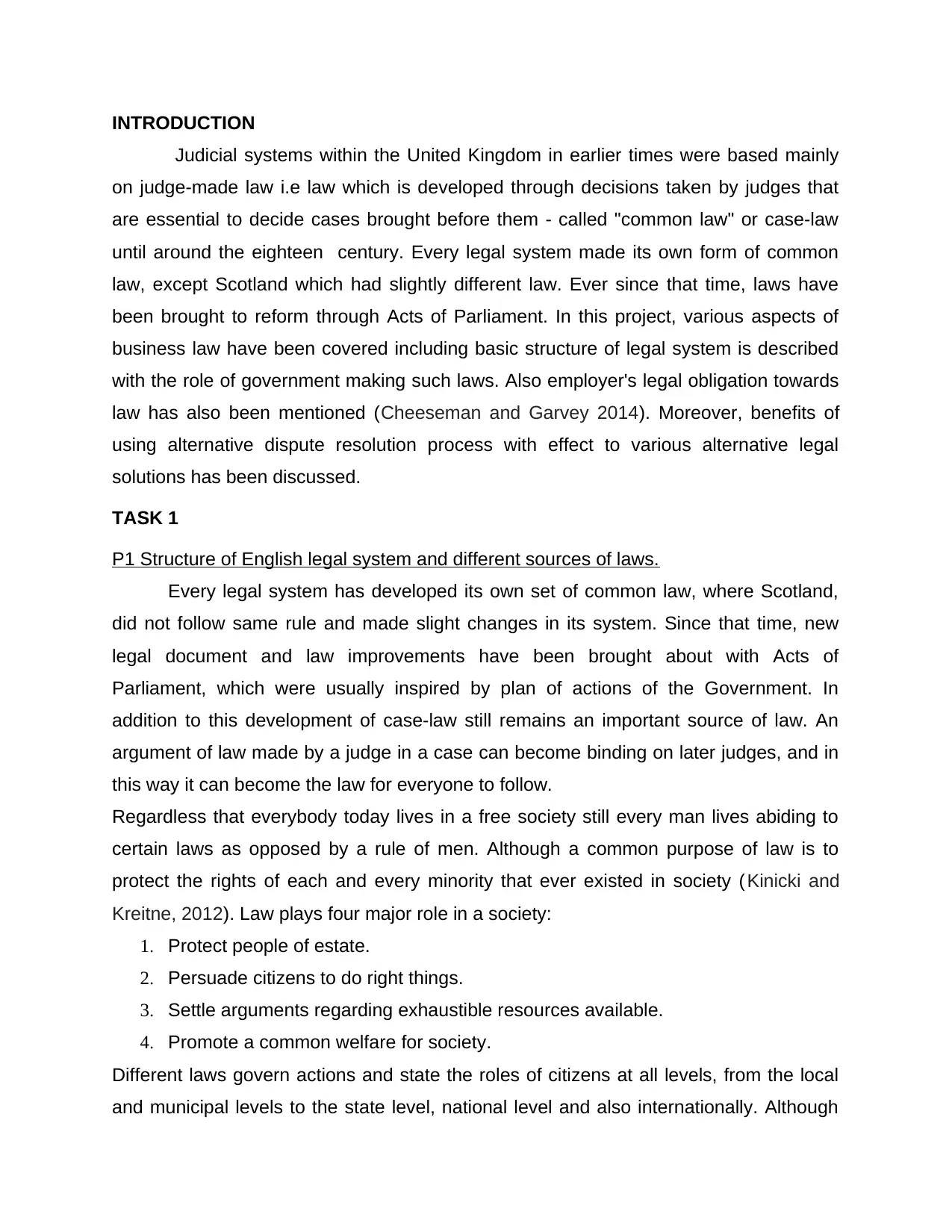
INTRODUCTION
Judicial systems within the United Kingdom in earlier times were based mainly
on judge-made law i.e law which is developed through decisions taken by judges that
are essential to decide cases brought before them - called "common law" or case-law
until around the eighteen century. Every legal system made its own form of common
law, except Scotland which had slightly different law. Ever since that time, laws have
been brought to reform through Acts of Parliament. In this project, various aspects of
business law have been covered including basic structure of legal system is described
with the role of government making such laws. Also employer's legal obligation towards
law has also been mentioned (Cheeseman and Garvey 2014). Moreover, benefits of
using alternative dispute resolution process with effect to various alternative legal
solutions has been discussed.
TASK 1
P1 Structure of English legal system and different sources of laws.
Every legal system has developed its own set of common law, where Scotland,
did not follow same rule and made slight changes in its system. Since that time, new
legal document and law improvements have been brought about with Acts of
Parliament, which were usually inspired by plan of actions of the Government. In
addition to this development of case-law still remains an important source of law. An
argument of law made by a judge in a case can become binding on later judges, and in
this way it can become the law for everyone to follow.
Regardless that everybody today lives in a free society still every man lives abiding to
certain laws as opposed by a rule of men. Although a common purpose of law is to
protect the rights of each and every minority that ever existed in society ( Kinicki and
Kreitne, 2012). Law plays four major role in a society:
1. Protect people of estate.
2. Persuade citizens to do right things.
3. Settle arguments regarding exhaustible resources available.
4. Promote a common welfare for society.
Different laws govern actions and state the roles of citizens at all levels, from the local
and municipal levels to the state level, national level and also internationally. Although
Judicial systems within the United Kingdom in earlier times were based mainly
on judge-made law i.e law which is developed through decisions taken by judges that
are essential to decide cases brought before them - called "common law" or case-law
until around the eighteen century. Every legal system made its own form of common
law, except Scotland which had slightly different law. Ever since that time, laws have
been brought to reform through Acts of Parliament. In this project, various aspects of
business law have been covered including basic structure of legal system is described
with the role of government making such laws. Also employer's legal obligation towards
law has also been mentioned (Cheeseman and Garvey 2014). Moreover, benefits of
using alternative dispute resolution process with effect to various alternative legal
solutions has been discussed.
TASK 1
P1 Structure of English legal system and different sources of laws.
Every legal system has developed its own set of common law, where Scotland,
did not follow same rule and made slight changes in its system. Since that time, new
legal document and law improvements have been brought about with Acts of
Parliament, which were usually inspired by plan of actions of the Government. In
addition to this development of case-law still remains an important source of law. An
argument of law made by a judge in a case can become binding on later judges, and in
this way it can become the law for everyone to follow.
Regardless that everybody today lives in a free society still every man lives abiding to
certain laws as opposed by a rule of men. Although a common purpose of law is to
protect the rights of each and every minority that ever existed in society ( Kinicki and
Kreitne, 2012). Law plays four major role in a society:
1. Protect people of estate.
2. Persuade citizens to do right things.
3. Settle arguments regarding exhaustible resources available.
4. Promote a common welfare for society.
Different laws govern actions and state the roles of citizens at all levels, from the local
and municipal levels to the state level, national level and also internationally. Although
⊘ This is a preview!⊘
Do you want full access?
Subscribe today to unlock all pages.

Trusted by 1+ million students worldwide
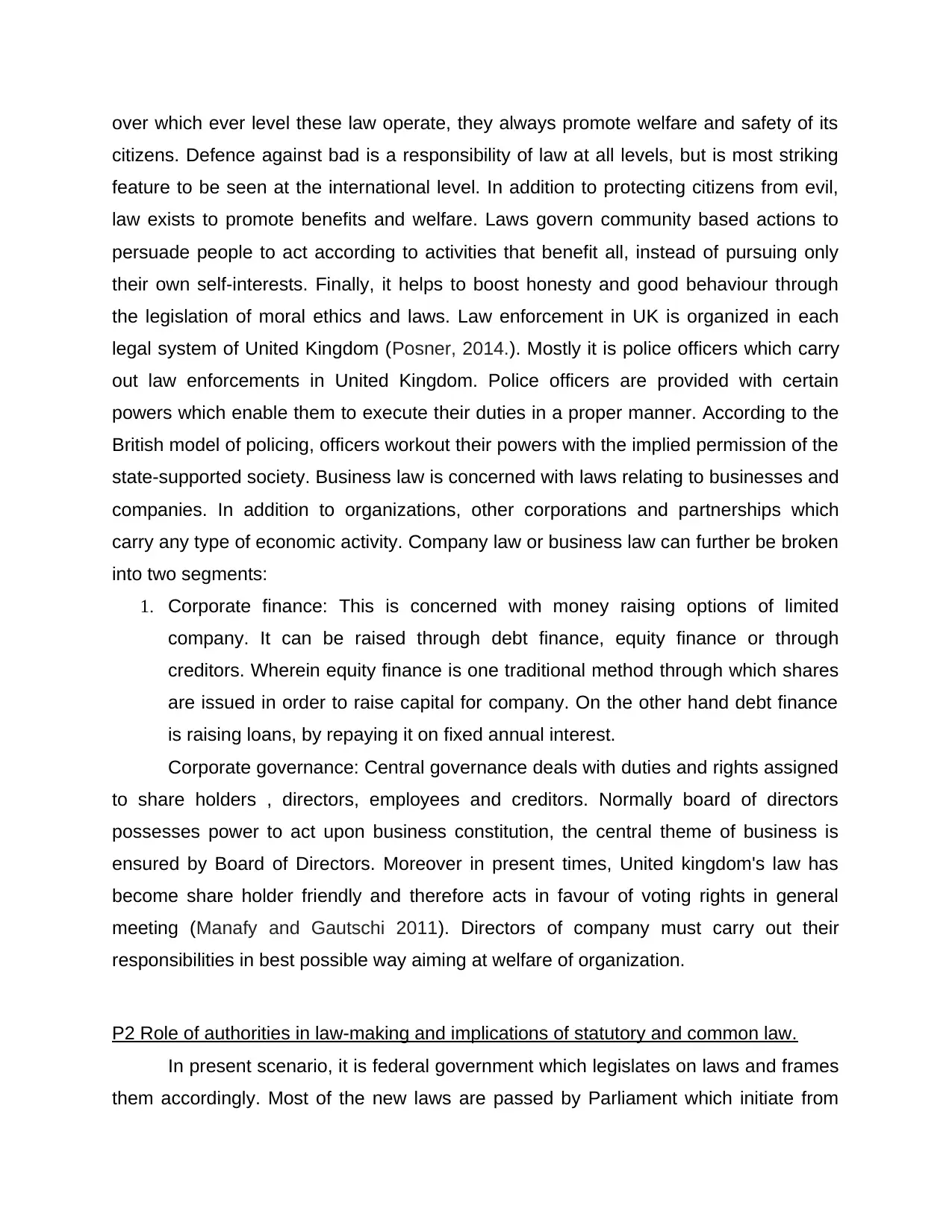
over which ever level these law operate, they always promote welfare and safety of its
citizens. Defence against bad is a responsibility of law at all levels, but is most striking
feature to be seen at the international level. In addition to protecting citizens from evil,
law exists to promote benefits and welfare. Laws govern community based actions to
persuade people to act according to activities that benefit all, instead of pursuing only
their own self-interests. Finally, it helps to boost honesty and good behaviour through
the legislation of moral ethics and laws. Law enforcement in UK is organized in each
legal system of United Kingdom (Posner, 2014.). Mostly it is police officers which carry
out law enforcements in United Kingdom. Police officers are provided with certain
powers which enable them to execute their duties in a proper manner. According to the
British model of policing, officers workout their powers with the implied permission of the
state-supported society. Business law is concerned with laws relating to businesses and
companies. In addition to organizations, other corporations and partnerships which
carry any type of economic activity. Company law or business law can further be broken
into two segments:
1. Corporate finance: This is concerned with money raising options of limited
company. It can be raised through debt finance, equity finance or through
creditors. Wherein equity finance is one traditional method through which shares
are issued in order to raise capital for company. On the other hand debt finance
is raising loans, by repaying it on fixed annual interest.
Corporate governance: Central governance deals with duties and rights assigned
to share holders , directors, employees and creditors. Normally board of directors
possesses power to act upon business constitution, the central theme of business is
ensured by Board of Directors. Moreover in present times, United kingdom's law has
become share holder friendly and therefore acts in favour of voting rights in general
meeting (Manafy and Gautschi 2011). Directors of company must carry out their
responsibilities in best possible way aiming at welfare of organization.
P2 Role of authorities in law-making and implications of statutory and common law.
In present scenario, it is federal government which legislates on laws and frames
them accordingly. Most of the new laws are passed by Parliament which initiate from
citizens. Defence against bad is a responsibility of law at all levels, but is most striking
feature to be seen at the international level. In addition to protecting citizens from evil,
law exists to promote benefits and welfare. Laws govern community based actions to
persuade people to act according to activities that benefit all, instead of pursuing only
their own self-interests. Finally, it helps to boost honesty and good behaviour through
the legislation of moral ethics and laws. Law enforcement in UK is organized in each
legal system of United Kingdom (Posner, 2014.). Mostly it is police officers which carry
out law enforcements in United Kingdom. Police officers are provided with certain
powers which enable them to execute their duties in a proper manner. According to the
British model of policing, officers workout their powers with the implied permission of the
state-supported society. Business law is concerned with laws relating to businesses and
companies. In addition to organizations, other corporations and partnerships which
carry any type of economic activity. Company law or business law can further be broken
into two segments:
1. Corporate finance: This is concerned with money raising options of limited
company. It can be raised through debt finance, equity finance or through
creditors. Wherein equity finance is one traditional method through which shares
are issued in order to raise capital for company. On the other hand debt finance
is raising loans, by repaying it on fixed annual interest.
Corporate governance: Central governance deals with duties and rights assigned
to share holders , directors, employees and creditors. Normally board of directors
possesses power to act upon business constitution, the central theme of business is
ensured by Board of Directors. Moreover in present times, United kingdom's law has
become share holder friendly and therefore acts in favour of voting rights in general
meeting (Manafy and Gautschi 2011). Directors of company must carry out their
responsibilities in best possible way aiming at welfare of organization.
P2 Role of authorities in law-making and implications of statutory and common law.
In present scenario, it is federal government which legislates on laws and frames
them accordingly. Most of the new laws are passed by Parliament which initiate from
Paraphrase This Document
Need a fresh take? Get an instant paraphrase of this document with our AI Paraphraser
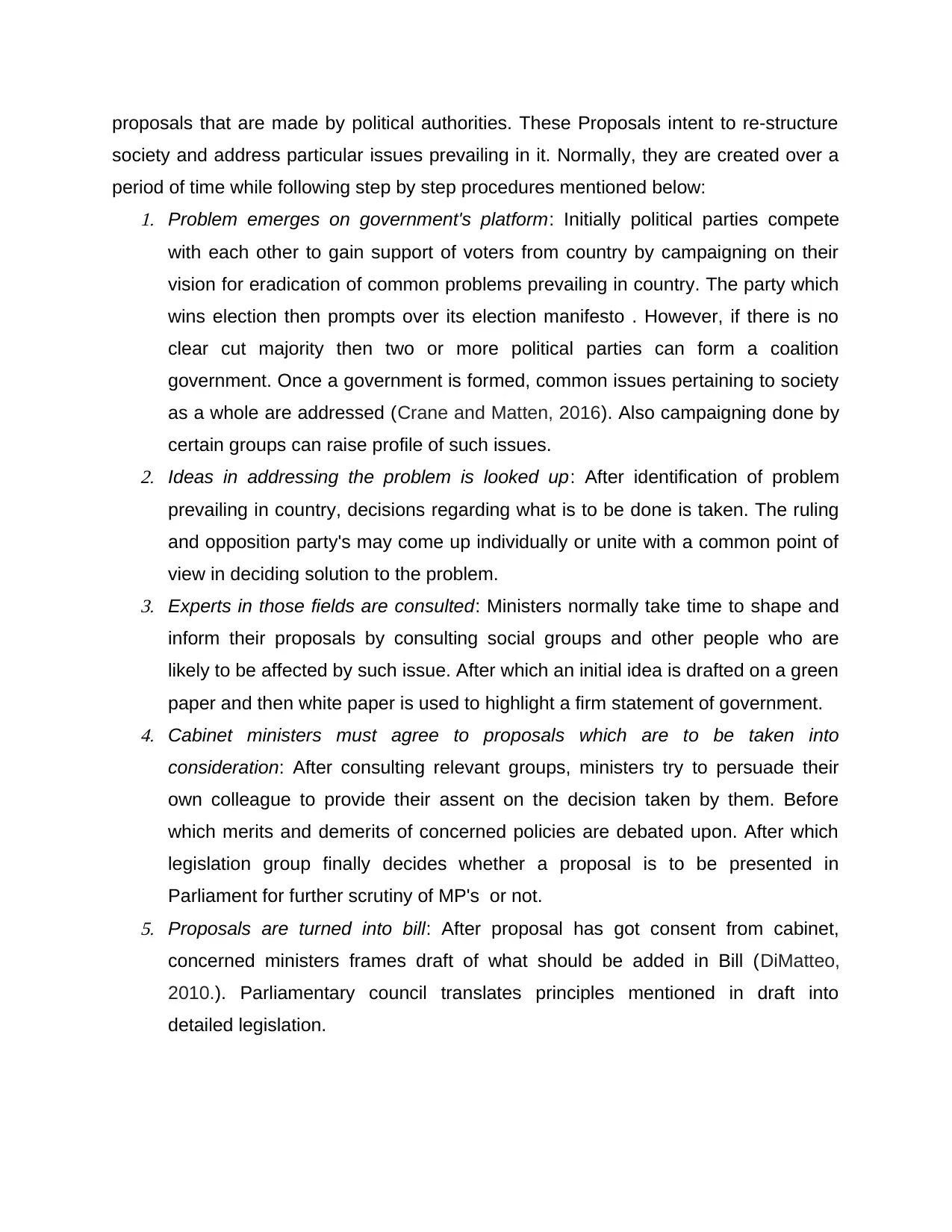
proposals that are made by political authorities. These Proposals intent to re-structure
society and address particular issues prevailing in it. Normally, they are created over a
period of time while following step by step procedures mentioned below:1. Problem emerges on government's platform: Initially political parties compete
with each other to gain support of voters from country by campaigning on their
vision for eradication of common problems prevailing in country. The party which
wins election then prompts over its election manifesto . However, if there is no
clear cut majority then two or more political parties can form a coalition
government. Once a government is formed, common issues pertaining to society
as a whole are addressed (Crane and Matten, 2016). Also campaigning done by
certain groups can raise profile of such issues.2. Ideas in addressing the problem is looked up: After identification of problem
prevailing in country, decisions regarding what is to be done is taken. The ruling
and opposition party's may come up individually or unite with a common point of
view in deciding solution to the problem.3. Experts in those fields are consulted: Ministers normally take time to shape and
inform their proposals by consulting social groups and other people who are
likely to be affected by such issue. After which an initial idea is drafted on a green
paper and then white paper is used to highlight a firm statement of government.4. Cabinet ministers must agree to proposals which are to be taken into
consideration: After consulting relevant groups, ministers try to persuade their
own colleague to provide their assent on the decision taken by them. Before
which merits and demerits of concerned policies are debated upon. After which
legislation group finally decides whether a proposal is to be presented in
Parliament for further scrutiny of MP's or not.5. Proposals are turned into bill: After proposal has got consent from cabinet,
concerned ministers frames draft of what should be added in Bill (DiMatteo,
2010.). Parliamentary council translates principles mentioned in draft into
detailed legislation.
society and address particular issues prevailing in it. Normally, they are created over a
period of time while following step by step procedures mentioned below:1. Problem emerges on government's platform: Initially political parties compete
with each other to gain support of voters from country by campaigning on their
vision for eradication of common problems prevailing in country. The party which
wins election then prompts over its election manifesto . However, if there is no
clear cut majority then two or more political parties can form a coalition
government. Once a government is formed, common issues pertaining to society
as a whole are addressed (Crane and Matten, 2016). Also campaigning done by
certain groups can raise profile of such issues.2. Ideas in addressing the problem is looked up: After identification of problem
prevailing in country, decisions regarding what is to be done is taken. The ruling
and opposition party's may come up individually or unite with a common point of
view in deciding solution to the problem.3. Experts in those fields are consulted: Ministers normally take time to shape and
inform their proposals by consulting social groups and other people who are
likely to be affected by such issue. After which an initial idea is drafted on a green
paper and then white paper is used to highlight a firm statement of government.4. Cabinet ministers must agree to proposals which are to be taken into
consideration: After consulting relevant groups, ministers try to persuade their
own colleague to provide their assent on the decision taken by them. Before
which merits and demerits of concerned policies are debated upon. After which
legislation group finally decides whether a proposal is to be presented in
Parliament for further scrutiny of MP's or not.5. Proposals are turned into bill: After proposal has got consent from cabinet,
concerned ministers frames draft of what should be added in Bill (DiMatteo,
2010.). Parliamentary council translates principles mentioned in draft into
detailed legislation.
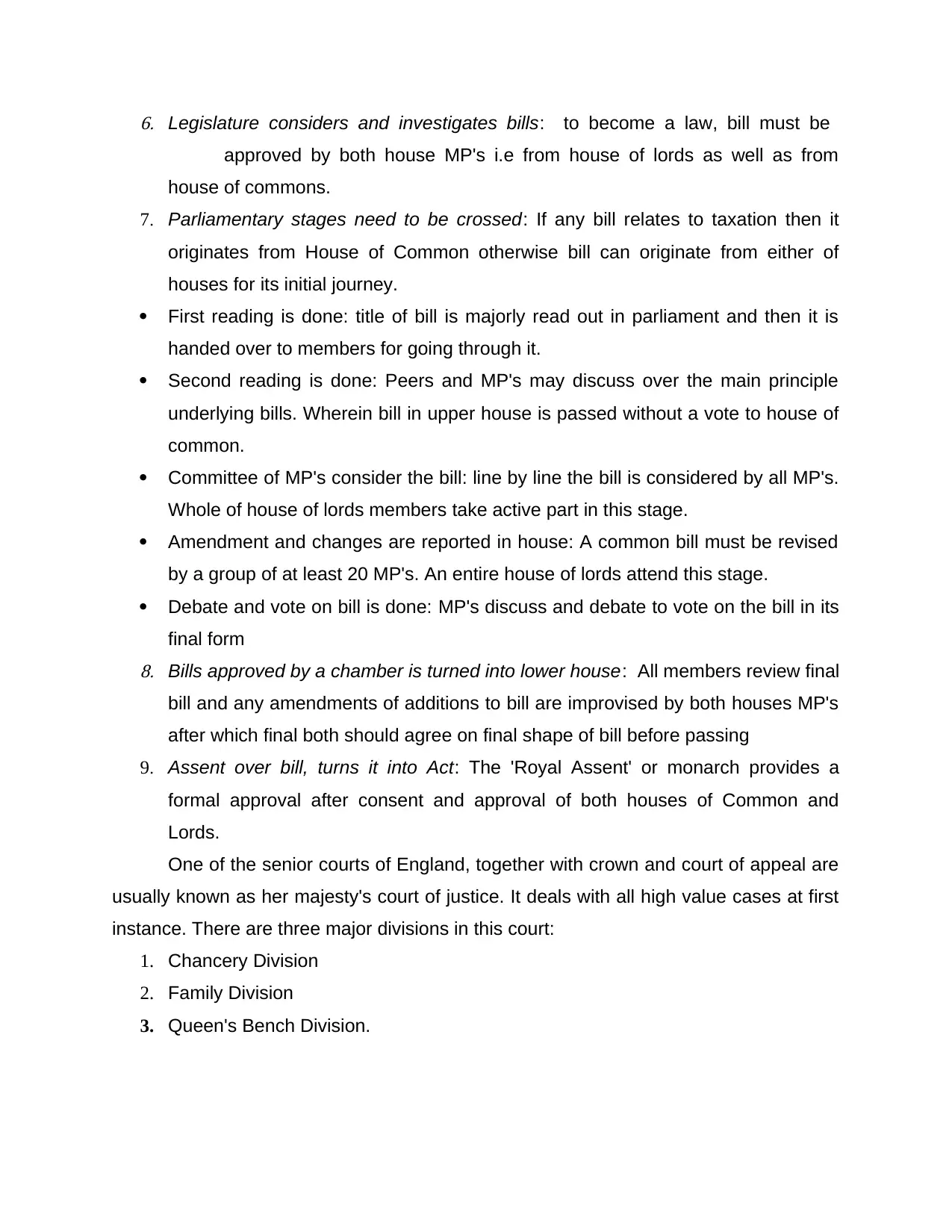
6. Legislature considers and investigates bills: to become a law, bill must be
approved by both house MP's i.e from house of lords as well as from
house of commons.
7. Parliamentary stages need to be crossed: If any bill relates to taxation then it
originates from House of Common otherwise bill can originate from either of
houses for its initial journey.
First reading is done: title of bill is majorly read out in parliament and then it is
handed over to members for going through it.
Second reading is done: Peers and MP's may discuss over the main principle
underlying bills. Wherein bill in upper house is passed without a vote to house of
common.
Committee of MP's consider the bill: line by line the bill is considered by all MP's.
Whole of house of lords members take active part in this stage.
Amendment and changes are reported in house: A common bill must be revised
by a group of at least 20 MP's. An entire house of lords attend this stage.
Debate and vote on bill is done: MP's discuss and debate to vote on the bill in its
final form8. Bills approved by a chamber is turned into lower house: All members review final
bill and any amendments of additions to bill are improvised by both houses MP's
after which final both should agree on final shape of bill before passing
9. Assent over bill, turns it into Act: The 'Royal Assent' or monarch provides a
formal approval after consent and approval of both houses of Common and
Lords.
One of the senior courts of England, together with crown and court of appeal are
usually known as her majesty's court of justice. It deals with all high value cases at first
instance. There are three major divisions in this court:
1. Chancery Division
2. Family Division
3. Queen's Bench Division.
approved by both house MP's i.e from house of lords as well as from
house of commons.
7. Parliamentary stages need to be crossed: If any bill relates to taxation then it
originates from House of Common otherwise bill can originate from either of
houses for its initial journey.
First reading is done: title of bill is majorly read out in parliament and then it is
handed over to members for going through it.
Second reading is done: Peers and MP's may discuss over the main principle
underlying bills. Wherein bill in upper house is passed without a vote to house of
common.
Committee of MP's consider the bill: line by line the bill is considered by all MP's.
Whole of house of lords members take active part in this stage.
Amendment and changes are reported in house: A common bill must be revised
by a group of at least 20 MP's. An entire house of lords attend this stage.
Debate and vote on bill is done: MP's discuss and debate to vote on the bill in its
final form8. Bills approved by a chamber is turned into lower house: All members review final
bill and any amendments of additions to bill are improvised by both houses MP's
after which final both should agree on final shape of bill before passing
9. Assent over bill, turns it into Act: The 'Royal Assent' or monarch provides a
formal approval after consent and approval of both houses of Common and
Lords.
One of the senior courts of England, together with crown and court of appeal are
usually known as her majesty's court of justice. It deals with all high value cases at first
instance. There are three major divisions in this court:
1. Chancery Division
2. Family Division
3. Queen's Bench Division.
⊘ This is a preview!⊘
Do you want full access?
Subscribe today to unlock all pages.

Trusted by 1+ million students worldwide
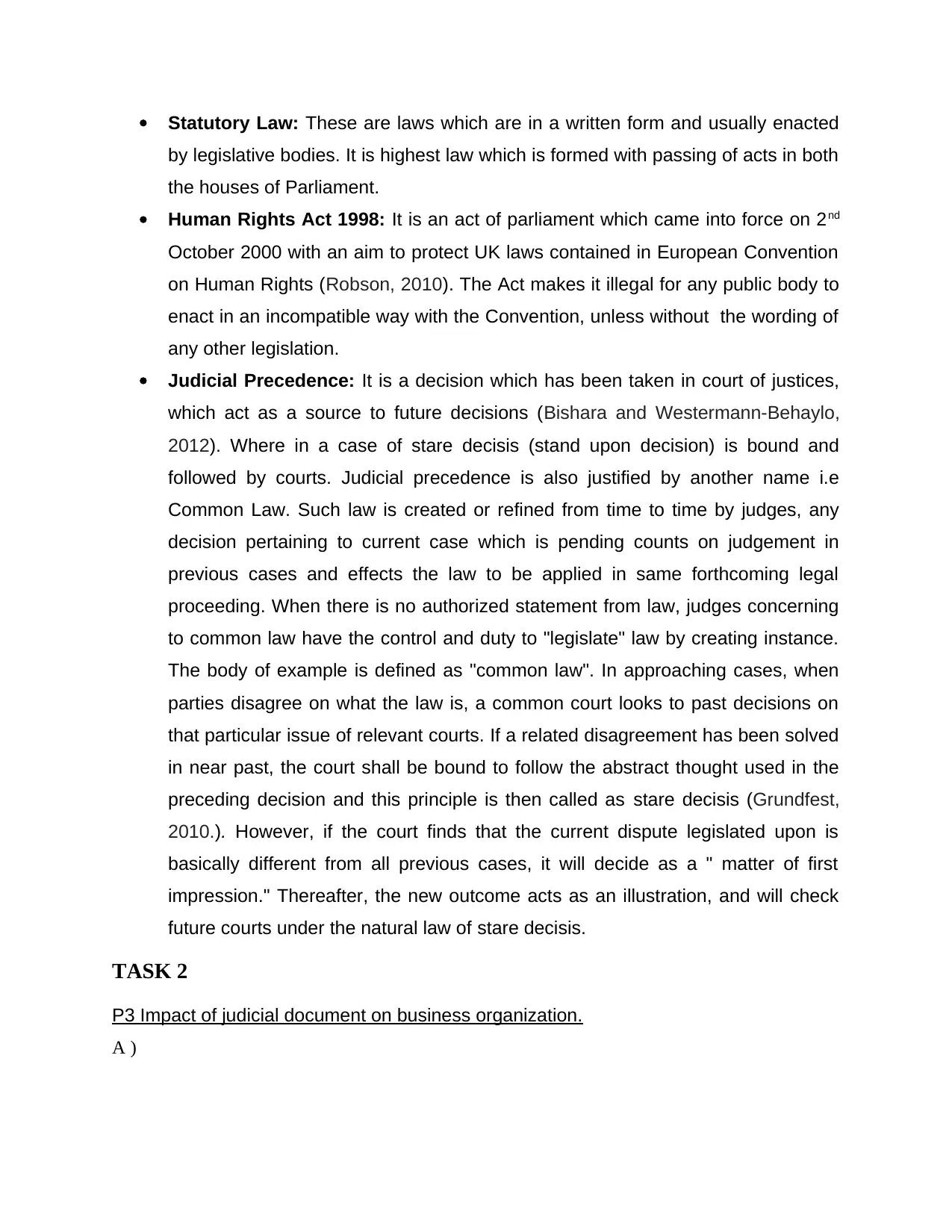
Statutory Law: These are laws which are in a written form and usually enacted
by legislative bodies. It is highest law which is formed with passing of acts in both
the houses of Parliament.
Human Rights Act 1998: It is an act of parliament which came into force on 2nd
October 2000 with an aim to protect UK laws contained in European Convention
on Human Rights (Robson, 2010). The Act makes it illegal for any public body to
enact in an incompatible way with the Convention, unless without the wording of
any other legislation.
Judicial Precedence: It is a decision which has been taken in court of justices,
which act as a source to future decisions (Bishara and Westermann‐Behaylo,
2012). Where in a case of stare decisis (stand upon decision) is bound and
followed by courts. Judicial precedence is also justified by another name i.e
Common Law. Such law is created or refined from time to time by judges, any
decision pertaining to current case which is pending counts on judgement in
previous cases and effects the law to be applied in same forthcoming legal
proceeding. When there is no authorized statement from law, judges concerning
to common law have the control and duty to "legislate" law by creating instance.
The body of example is defined as "common law". In approaching cases, when
parties disagree on what the law is, a common court looks to past decisions on
that particular issue of relevant courts. If a related disagreement has been solved
in near past, the court shall be bound to follow the abstract thought used in the
preceding decision and this principle is then called as stare decisis (Grundfest,
2010.). However, if the court finds that the current dispute legislated upon is
basically different from all previous cases, it will decide as a " matter of first
impression." Thereafter, the new outcome acts as an illustration, and will check
future courts under the natural law of stare decisis.
TASK 2
P3 Impact of judicial document on business organization.
A )
by legislative bodies. It is highest law which is formed with passing of acts in both
the houses of Parliament.
Human Rights Act 1998: It is an act of parliament which came into force on 2nd
October 2000 with an aim to protect UK laws contained in European Convention
on Human Rights (Robson, 2010). The Act makes it illegal for any public body to
enact in an incompatible way with the Convention, unless without the wording of
any other legislation.
Judicial Precedence: It is a decision which has been taken in court of justices,
which act as a source to future decisions (Bishara and Westermann‐Behaylo,
2012). Where in a case of stare decisis (stand upon decision) is bound and
followed by courts. Judicial precedence is also justified by another name i.e
Common Law. Such law is created or refined from time to time by judges, any
decision pertaining to current case which is pending counts on judgement in
previous cases and effects the law to be applied in same forthcoming legal
proceeding. When there is no authorized statement from law, judges concerning
to common law have the control and duty to "legislate" law by creating instance.
The body of example is defined as "common law". In approaching cases, when
parties disagree on what the law is, a common court looks to past decisions on
that particular issue of relevant courts. If a related disagreement has been solved
in near past, the court shall be bound to follow the abstract thought used in the
preceding decision and this principle is then called as stare decisis (Grundfest,
2010.). However, if the court finds that the current dispute legislated upon is
basically different from all previous cases, it will decide as a " matter of first
impression." Thereafter, the new outcome acts as an illustration, and will check
future courts under the natural law of stare decisis.
TASK 2
P3 Impact of judicial document on business organization.
A )
Paraphrase This Document
Need a fresh take? Get an instant paraphrase of this document with our AI Paraphraser
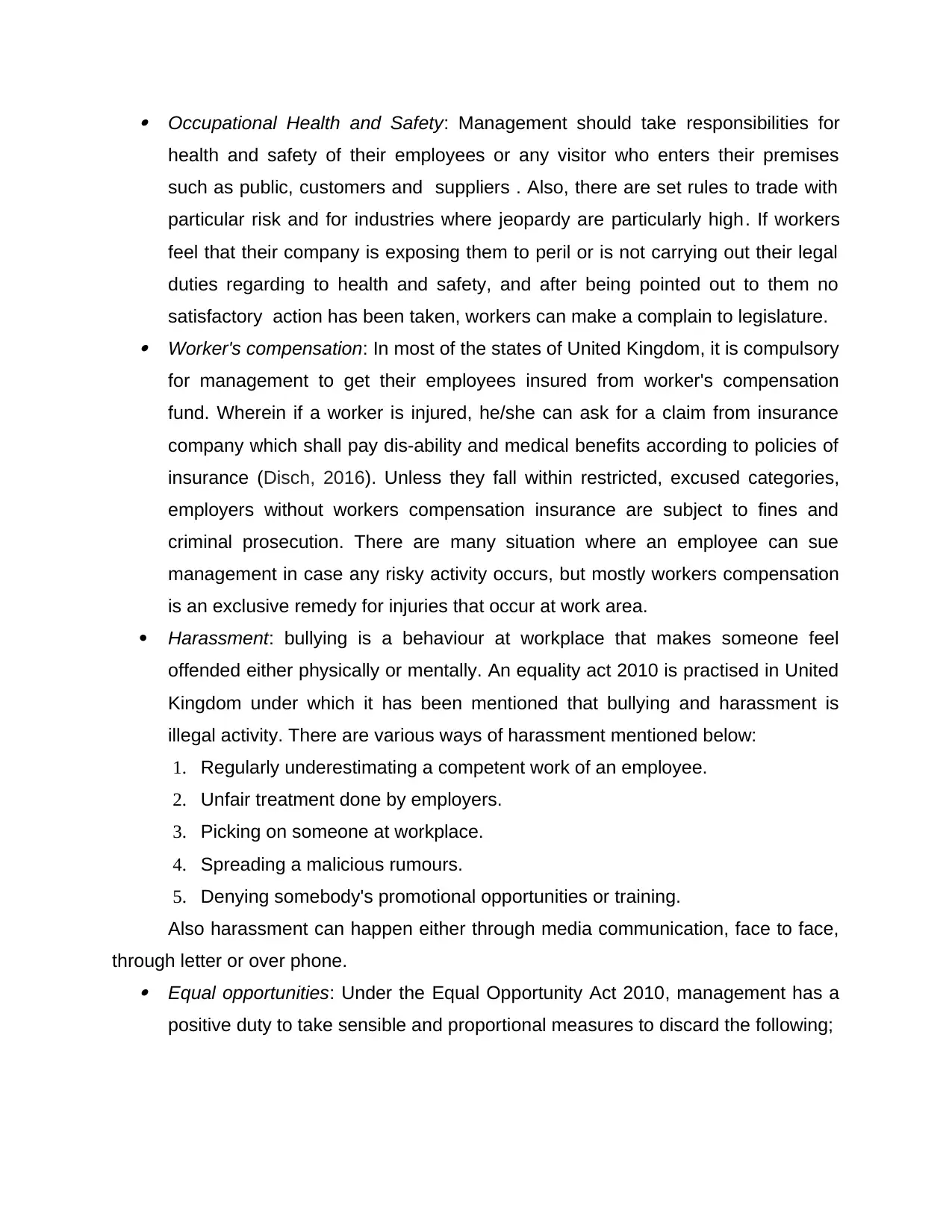
Occupational Health and Safety: Management should take responsibilities for
health and safety of their employees or any visitor who enters their premises
such as public, customers and suppliers . Also, there are set rules to trade with
particular risk and for industries where jeopardy are particularly high. If workers
feel that their company is exposing them to peril or is not carrying out their legal
duties regarding to health and safety, and after being pointed out to them no
satisfactory action has been taken, workers can make a complain to legislature. Worker's compensation: In most of the states of United Kingdom, it is compulsory
for management to get their employees insured from worker's compensation
fund. Wherein if a worker is injured, he/she can ask for a claim from insurance
company which shall pay dis-ability and medical benefits according to policies of
insurance (Disch, 2016). Unless they fall within restricted, excused categories,
employers without workers compensation insurance are subject to fines and
criminal prosecution. There are many situation where an employee can sue
management in case any risky activity occurs, but mostly workers compensation
is an exclusive remedy for injuries that occur at work area.
Harassment: bullying is a behaviour at workplace that makes someone feel
offended either physically or mentally. An equality act 2010 is practised in United
Kingdom under which it has been mentioned that bullying and harassment is
illegal activity. There are various ways of harassment mentioned below:
1. Regularly underestimating a competent work of an employee.
2. Unfair treatment done by employers.
3. Picking on someone at workplace.
4. Spreading a malicious rumours.
5. Denying somebody's promotional opportunities or training.
Also harassment can happen either through media communication, face to face,
through letter or over phone. Equal opportunities: Under the Equal Opportunity Act 2010, management has a
positive duty to take sensible and proportional measures to discard the following;
health and safety of their employees or any visitor who enters their premises
such as public, customers and suppliers . Also, there are set rules to trade with
particular risk and for industries where jeopardy are particularly high. If workers
feel that their company is exposing them to peril or is not carrying out their legal
duties regarding to health and safety, and after being pointed out to them no
satisfactory action has been taken, workers can make a complain to legislature. Worker's compensation: In most of the states of United Kingdom, it is compulsory
for management to get their employees insured from worker's compensation
fund. Wherein if a worker is injured, he/she can ask for a claim from insurance
company which shall pay dis-ability and medical benefits according to policies of
insurance (Disch, 2016). Unless they fall within restricted, excused categories,
employers without workers compensation insurance are subject to fines and
criminal prosecution. There are many situation where an employee can sue
management in case any risky activity occurs, but mostly workers compensation
is an exclusive remedy for injuries that occur at work area.
Harassment: bullying is a behaviour at workplace that makes someone feel
offended either physically or mentally. An equality act 2010 is practised in United
Kingdom under which it has been mentioned that bullying and harassment is
illegal activity. There are various ways of harassment mentioned below:
1. Regularly underestimating a competent work of an employee.
2. Unfair treatment done by employers.
3. Picking on someone at workplace.
4. Spreading a malicious rumours.
5. Denying somebody's promotional opportunities or training.
Also harassment can happen either through media communication, face to face,
through letter or over phone. Equal opportunities: Under the Equal Opportunity Act 2010, management has a
positive duty to take sensible and proportional measures to discard the following;
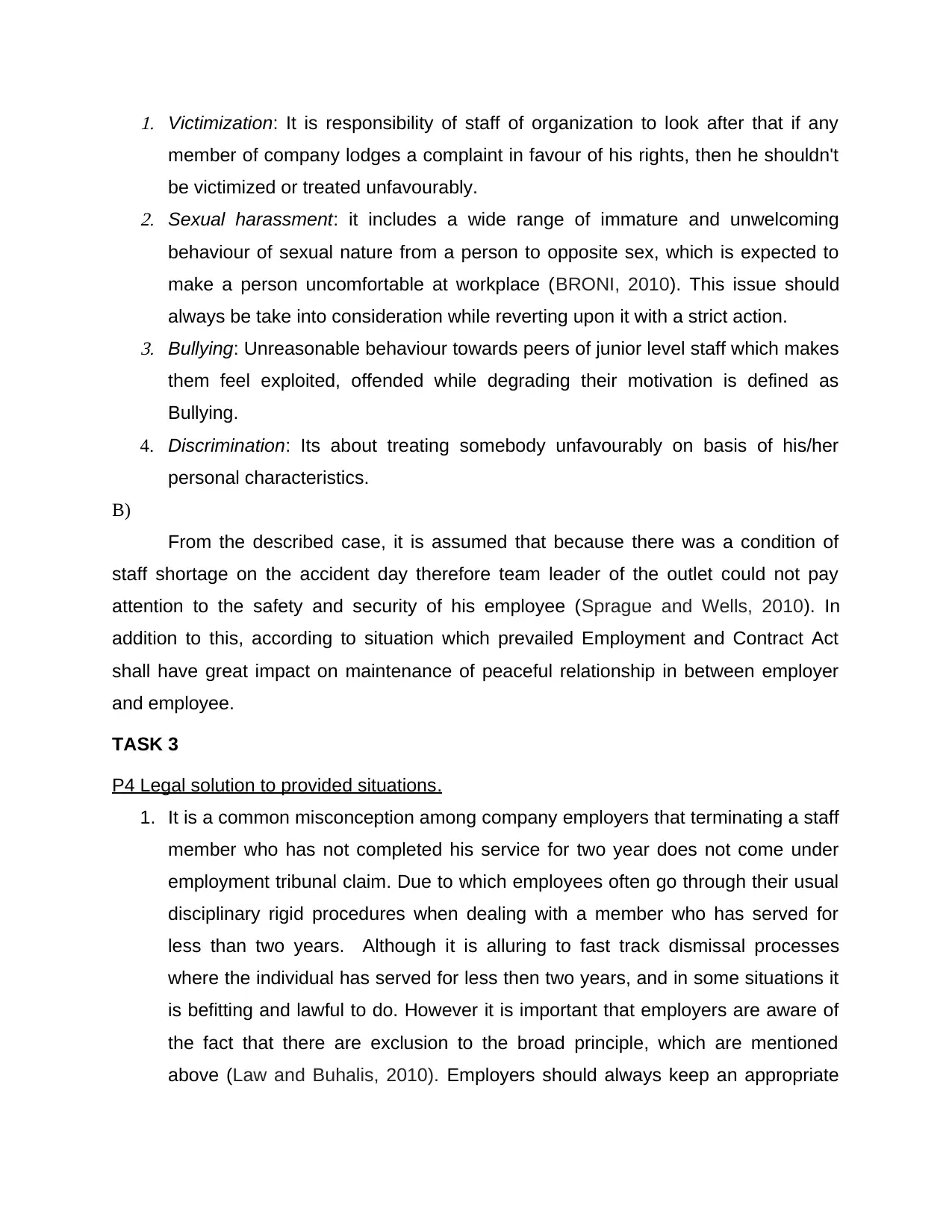
1. Victimization: It is responsibility of staff of organization to look after that if any
member of company lodges a complaint in favour of his rights, then he shouldn't
be victimized or treated unfavourably.2. Sexual harassment: it includes a wide range of immature and unwelcoming
behaviour of sexual nature from a person to opposite sex, which is expected to
make a person uncomfortable at workplace (BRONI, 2010). This issue should
always be take into consideration while reverting upon it with a strict action.3. Bullying: Unreasonable behaviour towards peers of junior level staff which makes
them feel exploited, offended while degrading their motivation is defined as
Bullying.
4. Discrimination: Its about treating somebody unfavourably on basis of his/her
personal characteristics.
B)
From the described case, it is assumed that because there was a condition of
staff shortage on the accident day therefore team leader of the outlet could not pay
attention to the safety and security of his employee (Sprague and Wells, 2010). In
addition to this, according to situation which prevailed Employment and Contract Act
shall have great impact on maintenance of peaceful relationship in between employer
and employee.
TASK 3
P4 Legal solution to provided situations.
1. It is a common misconception among company employers that terminating a staff
member who has not completed his service for two year does not come under
employment tribunal claim. Due to which employees often go through their usual
disciplinary rigid procedures when dealing with a member who has served for
less than two years. Although it is alluring to fast track dismissal processes
where the individual has served for less then two years, and in some situations it
is befitting and lawful to do. However it is important that employers are aware of
the fact that there are exclusion to the broad principle, which are mentioned
above (Law and Buhalis, 2010). Employers should always keep an appropriate
member of company lodges a complaint in favour of his rights, then he shouldn't
be victimized or treated unfavourably.2. Sexual harassment: it includes a wide range of immature and unwelcoming
behaviour of sexual nature from a person to opposite sex, which is expected to
make a person uncomfortable at workplace (BRONI, 2010). This issue should
always be take into consideration while reverting upon it with a strict action.3. Bullying: Unreasonable behaviour towards peers of junior level staff which makes
them feel exploited, offended while degrading their motivation is defined as
Bullying.
4. Discrimination: Its about treating somebody unfavourably on basis of his/her
personal characteristics.
B)
From the described case, it is assumed that because there was a condition of
staff shortage on the accident day therefore team leader of the outlet could not pay
attention to the safety and security of his employee (Sprague and Wells, 2010). In
addition to this, according to situation which prevailed Employment and Contract Act
shall have great impact on maintenance of peaceful relationship in between employer
and employee.
TASK 3
P4 Legal solution to provided situations.
1. It is a common misconception among company employers that terminating a staff
member who has not completed his service for two year does not come under
employment tribunal claim. Due to which employees often go through their usual
disciplinary rigid procedures when dealing with a member who has served for
less than two years. Although it is alluring to fast track dismissal processes
where the individual has served for less then two years, and in some situations it
is befitting and lawful to do. However it is important that employers are aware of
the fact that there are exclusion to the broad principle, which are mentioned
above (Law and Buhalis, 2010). Employers should always keep an appropriate
⊘ This is a preview!⊘
Do you want full access?
Subscribe today to unlock all pages.

Trusted by 1+ million students worldwide
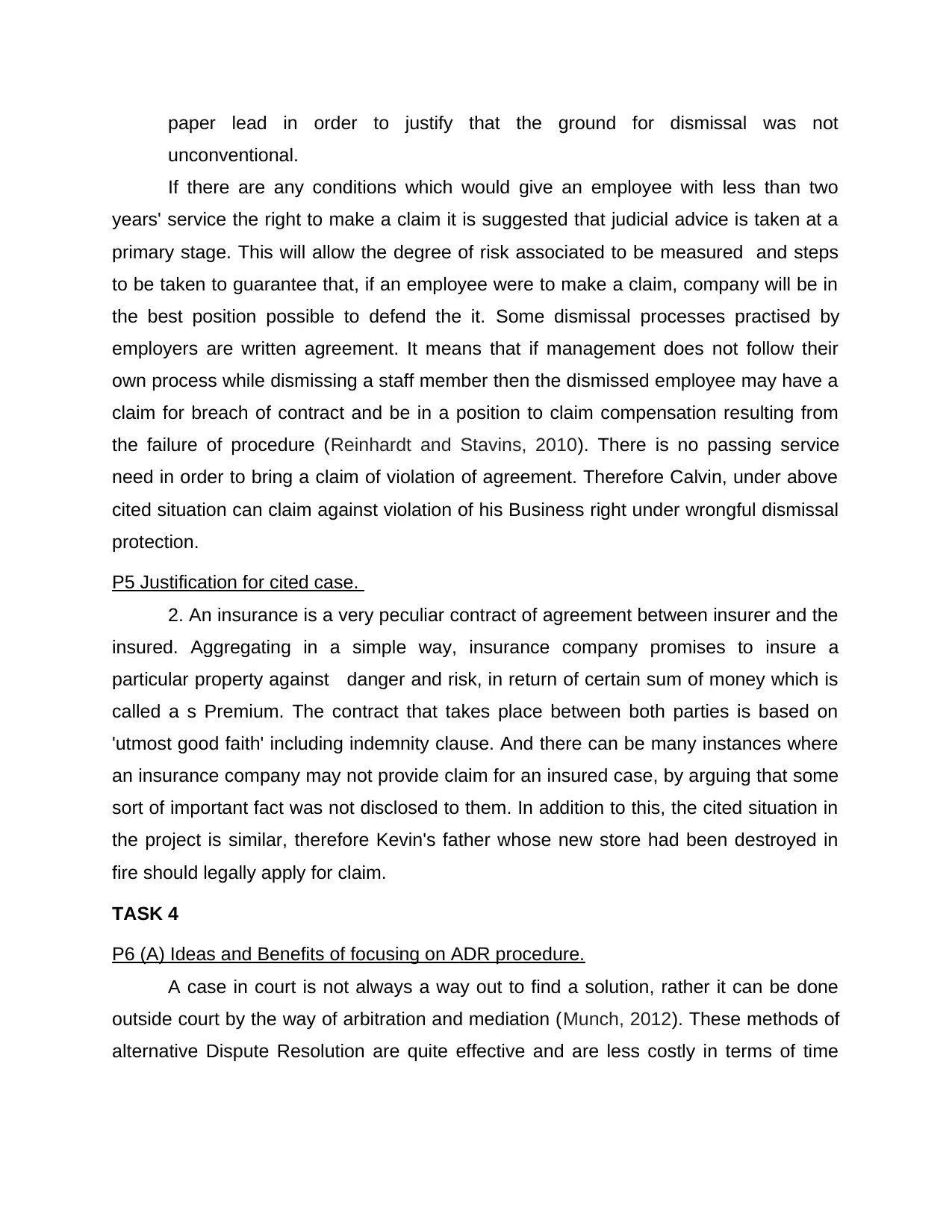
paper lead in order to justify that the ground for dismissal was not
unconventional.
If there are any conditions which would give an employee with less than two
years' service the right to make a claim it is suggested that judicial advice is taken at a
primary stage. This will allow the degree of risk associated to be measured and steps
to be taken to guarantee that, if an employee were to make a claim, company will be in
the best position possible to defend the it. Some dismissal processes practised by
employers are written agreement. It means that if management does not follow their
own process while dismissing a staff member then the dismissed employee may have a
claim for breach of contract and be in a position to claim compensation resulting from
the failure of procedure (Reinhardt and Stavins, 2010). There is no passing service
need in order to bring a claim of violation of agreement. Therefore Calvin, under above
cited situation can claim against violation of his Business right under wrongful dismissal
protection.
P5 Justification for cited case.
2. An insurance is a very peculiar contract of agreement between insurer and the
insured. Aggregating in a simple way, insurance company promises to insure a
particular property against danger and risk, in return of certain sum of money which is
called a s Premium. The contract that takes place between both parties is based on
'utmost good faith' including indemnity clause. And there can be many instances where
an insurance company may not provide claim for an insured case, by arguing that some
sort of important fact was not disclosed to them. In addition to this, the cited situation in
the project is similar, therefore Kevin's father whose new store had been destroyed in
fire should legally apply for claim.
TASK 4
P6 (A) Ideas and Benefits of focusing on ADR procedure.
A case in court is not always a way out to find a solution, rather it can be done
outside court by the way of arbitration and mediation (Munch, 2012). These methods of
alternative Dispute Resolution are quite effective and are less costly in terms of time
unconventional.
If there are any conditions which would give an employee with less than two
years' service the right to make a claim it is suggested that judicial advice is taken at a
primary stage. This will allow the degree of risk associated to be measured and steps
to be taken to guarantee that, if an employee were to make a claim, company will be in
the best position possible to defend the it. Some dismissal processes practised by
employers are written agreement. It means that if management does not follow their
own process while dismissing a staff member then the dismissed employee may have a
claim for breach of contract and be in a position to claim compensation resulting from
the failure of procedure (Reinhardt and Stavins, 2010). There is no passing service
need in order to bring a claim of violation of agreement. Therefore Calvin, under above
cited situation can claim against violation of his Business right under wrongful dismissal
protection.
P5 Justification for cited case.
2. An insurance is a very peculiar contract of agreement between insurer and the
insured. Aggregating in a simple way, insurance company promises to insure a
particular property against danger and risk, in return of certain sum of money which is
called a s Premium. The contract that takes place between both parties is based on
'utmost good faith' including indemnity clause. And there can be many instances where
an insurance company may not provide claim for an insured case, by arguing that some
sort of important fact was not disclosed to them. In addition to this, the cited situation in
the project is similar, therefore Kevin's father whose new store had been destroyed in
fire should legally apply for claim.
TASK 4
P6 (A) Ideas and Benefits of focusing on ADR procedure.
A case in court is not always a way out to find a solution, rather it can be done
outside court by the way of arbitration and mediation (Munch, 2012). These methods of
alternative Dispute Resolution are quite effective and are less costly in terms of time
Paraphrase This Document
Need a fresh take? Get an instant paraphrase of this document with our AI Paraphraser
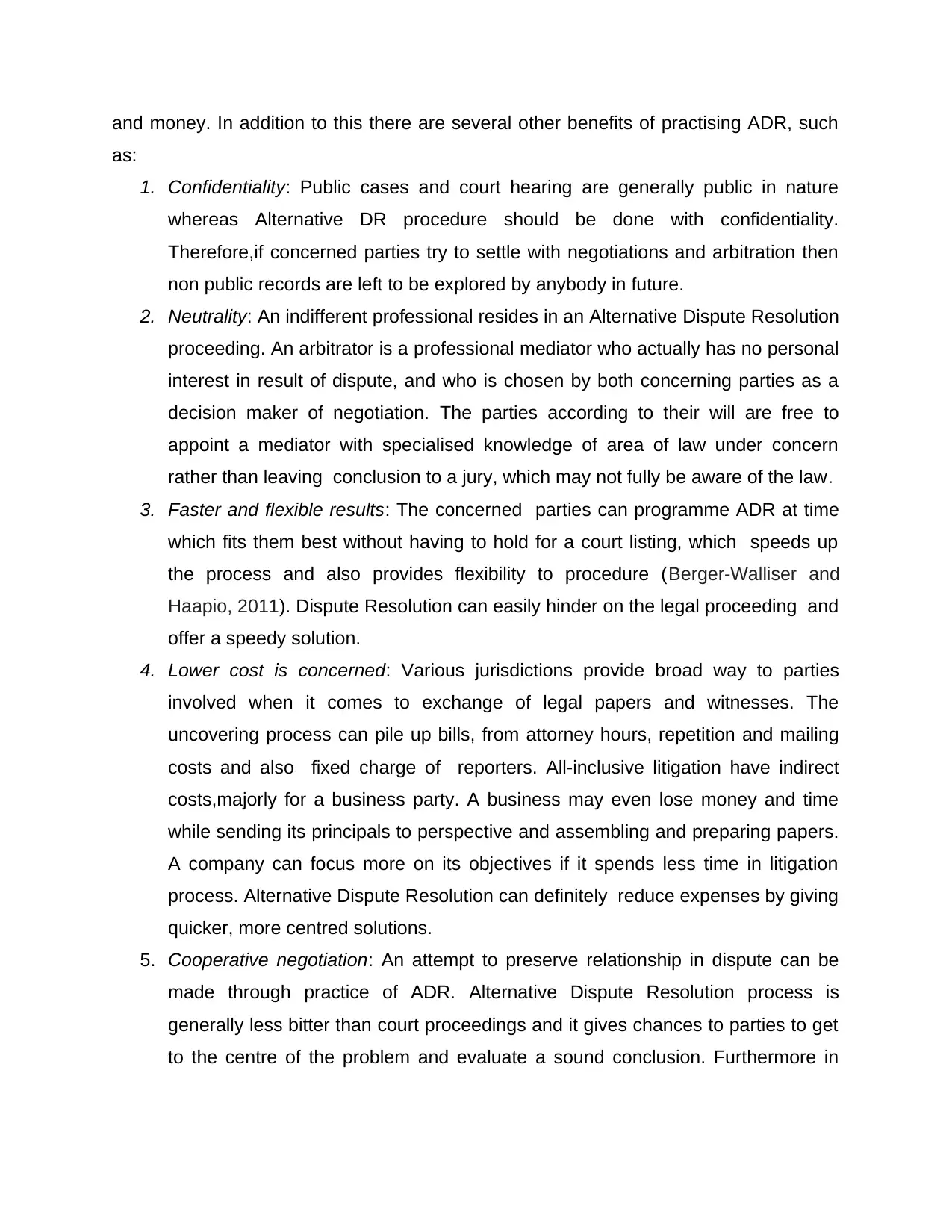
and money. In addition to this there are several other benefits of practising ADR, such
as:
1. Confidentiality: Public cases and court hearing are generally public in nature
whereas Alternative DR procedure should be done with confidentiality.
Therefore,if concerned parties try to settle with negotiations and arbitration then
non public records are left to be explored by anybody in future.
2. Neutrality: An indifferent professional resides in an Alternative Dispute Resolution
proceeding. An arbitrator is a professional mediator who actually has no personal
interest in result of dispute, and who is chosen by both concerning parties as a
decision maker of negotiation. The parties according to their will are free to
appoint a mediator with specialised knowledge of area of law under concern
rather than leaving conclusion to a jury, which may not fully be aware of the law.
3. Faster and flexible results: The concerned parties can programme ADR at time
which fits them best without having to hold for a court listing, which speeds up
the process and also provides flexibility to procedure (Berger-Walliser and
Haapio, 2011). Dispute Resolution can easily hinder on the legal proceeding and
offer a speedy solution.
4. Lower cost is concerned: Various jurisdictions provide broad way to parties
involved when it comes to exchange of legal papers and witnesses. The
uncovering process can pile up bills, from attorney hours, repetition and mailing
costs and also fixed charge of reporters. All-inclusive litigation have indirect
costs,majorly for a business party. A business may even lose money and time
while sending its principals to perspective and assembling and preparing papers.
A company can focus more on its objectives if it spends less time in litigation
process. Alternative Dispute Resolution can definitely reduce expenses by giving
quicker, more centred solutions.
5. Cooperative negotiation: An attempt to preserve relationship in dispute can be
made through practice of ADR. Alternative Dispute Resolution process is
generally less bitter than court proceedings and it gives chances to parties to get
to the centre of the problem and evaluate a sound conclusion. Furthermore in
as:
1. Confidentiality: Public cases and court hearing are generally public in nature
whereas Alternative DR procedure should be done with confidentiality.
Therefore,if concerned parties try to settle with negotiations and arbitration then
non public records are left to be explored by anybody in future.
2. Neutrality: An indifferent professional resides in an Alternative Dispute Resolution
proceeding. An arbitrator is a professional mediator who actually has no personal
interest in result of dispute, and who is chosen by both concerning parties as a
decision maker of negotiation. The parties according to their will are free to
appoint a mediator with specialised knowledge of area of law under concern
rather than leaving conclusion to a jury, which may not fully be aware of the law.
3. Faster and flexible results: The concerned parties can programme ADR at time
which fits them best without having to hold for a court listing, which speeds up
the process and also provides flexibility to procedure (Berger-Walliser and
Haapio, 2011). Dispute Resolution can easily hinder on the legal proceeding and
offer a speedy solution.
4. Lower cost is concerned: Various jurisdictions provide broad way to parties
involved when it comes to exchange of legal papers and witnesses. The
uncovering process can pile up bills, from attorney hours, repetition and mailing
costs and also fixed charge of reporters. All-inclusive litigation have indirect
costs,majorly for a business party. A business may even lose money and time
while sending its principals to perspective and assembling and preparing papers.
A company can focus more on its objectives if it spends less time in litigation
process. Alternative Dispute Resolution can definitely reduce expenses by giving
quicker, more centred solutions.
5. Cooperative negotiation: An attempt to preserve relationship in dispute can be
made through practice of ADR. Alternative Dispute Resolution process is
generally less bitter than court proceedings and it gives chances to parties to get
to the centre of the problem and evaluate a sound conclusion. Furthermore in
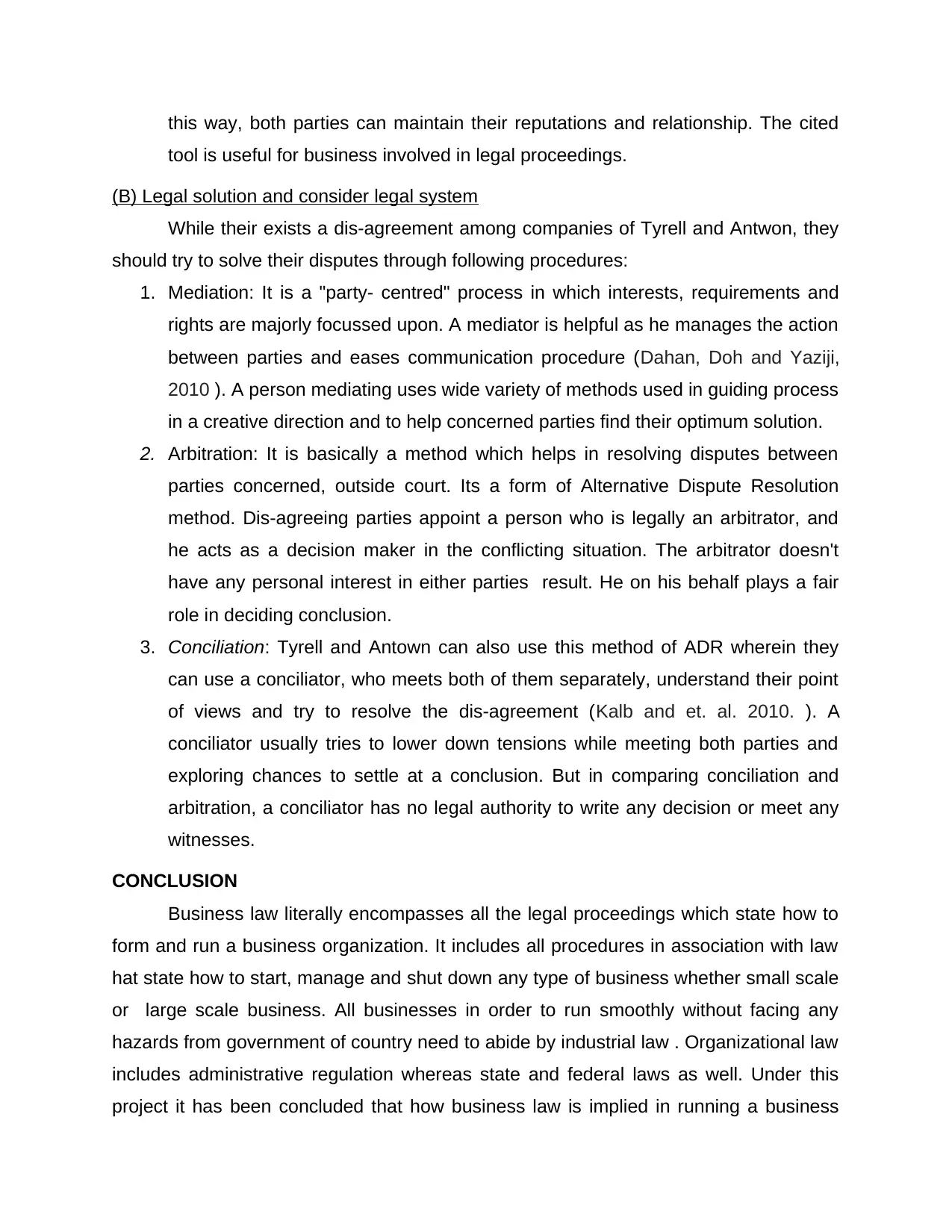
this way, both parties can maintain their reputations and relationship. The cited
tool is useful for business involved in legal proceedings.
(B) Legal solution and consider legal system
While their exists a dis-agreement among companies of Tyrell and Antwon, they
should try to solve their disputes through following procedures:
1. Mediation: It is a "party- centred" process in which interests, requirements and
rights are majorly focussed upon. A mediator is helpful as he manages the action
between parties and eases communication procedure (Dahan, Doh and Yaziji,
2010 ). A person mediating uses wide variety of methods used in guiding process
in a creative direction and to help concerned parties find their optimum solution.
2. Arbitration: It is basically a method which helps in resolving disputes between
parties concerned, outside court. Its a form of Alternative Dispute Resolution
method. Dis-agreeing parties appoint a person who is legally an arbitrator, and
he acts as a decision maker in the conflicting situation. The arbitrator doesn't
have any personal interest in either parties result. He on his behalf plays a fair
role in deciding conclusion.
3. Conciliation: Tyrell and Antown can also use this method of ADR wherein they
can use a conciliator, who meets both of them separately, understand their point
of views and try to resolve the dis-agreement (Kalb and et. al. 2010. ). A
conciliator usually tries to lower down tensions while meeting both parties and
exploring chances to settle at a conclusion. But in comparing conciliation and
arbitration, a conciliator has no legal authority to write any decision or meet any
witnesses.
CONCLUSION
Business law literally encompasses all the legal proceedings which state how to
form and run a business organization. It includes all procedures in association with law
hat state how to start, manage and shut down any type of business whether small scale
or large scale business. All businesses in order to run smoothly without facing any
hazards from government of country need to abide by industrial law . Organizational law
includes administrative regulation whereas state and federal laws as well. Under this
project it has been concluded that how business law is implied in running a business
tool is useful for business involved in legal proceedings.
(B) Legal solution and consider legal system
While their exists a dis-agreement among companies of Tyrell and Antwon, they
should try to solve their disputes through following procedures:
1. Mediation: It is a "party- centred" process in which interests, requirements and
rights are majorly focussed upon. A mediator is helpful as he manages the action
between parties and eases communication procedure (Dahan, Doh and Yaziji,
2010 ). A person mediating uses wide variety of methods used in guiding process
in a creative direction and to help concerned parties find their optimum solution.
2. Arbitration: It is basically a method which helps in resolving disputes between
parties concerned, outside court. Its a form of Alternative Dispute Resolution
method. Dis-agreeing parties appoint a person who is legally an arbitrator, and
he acts as a decision maker in the conflicting situation. The arbitrator doesn't
have any personal interest in either parties result. He on his behalf plays a fair
role in deciding conclusion.
3. Conciliation: Tyrell and Antown can also use this method of ADR wherein they
can use a conciliator, who meets both of them separately, understand their point
of views and try to resolve the dis-agreement (Kalb and et. al. 2010. ). A
conciliator usually tries to lower down tensions while meeting both parties and
exploring chances to settle at a conclusion. But in comparing conciliation and
arbitration, a conciliator has no legal authority to write any decision or meet any
witnesses.
CONCLUSION
Business law literally encompasses all the legal proceedings which state how to
form and run a business organization. It includes all procedures in association with law
hat state how to start, manage and shut down any type of business whether small scale
or large scale business. All businesses in order to run smoothly without facing any
hazards from government of country need to abide by industrial law . Organizational law
includes administrative regulation whereas state and federal laws as well. Under this
project it has been concluded that how business law is implied in running a business
⊘ This is a preview!⊘
Do you want full access?
Subscribe today to unlock all pages.

Trusted by 1+ million students worldwide
1 out of 15
Related Documents
Your All-in-One AI-Powered Toolkit for Academic Success.
+13062052269
info@desklib.com
Available 24*7 on WhatsApp / Email
![[object Object]](/_next/static/media/star-bottom.7253800d.svg)
Unlock your academic potential
Copyright © 2020–2025 A2Z Services. All Rights Reserved. Developed and managed by ZUCOL.





